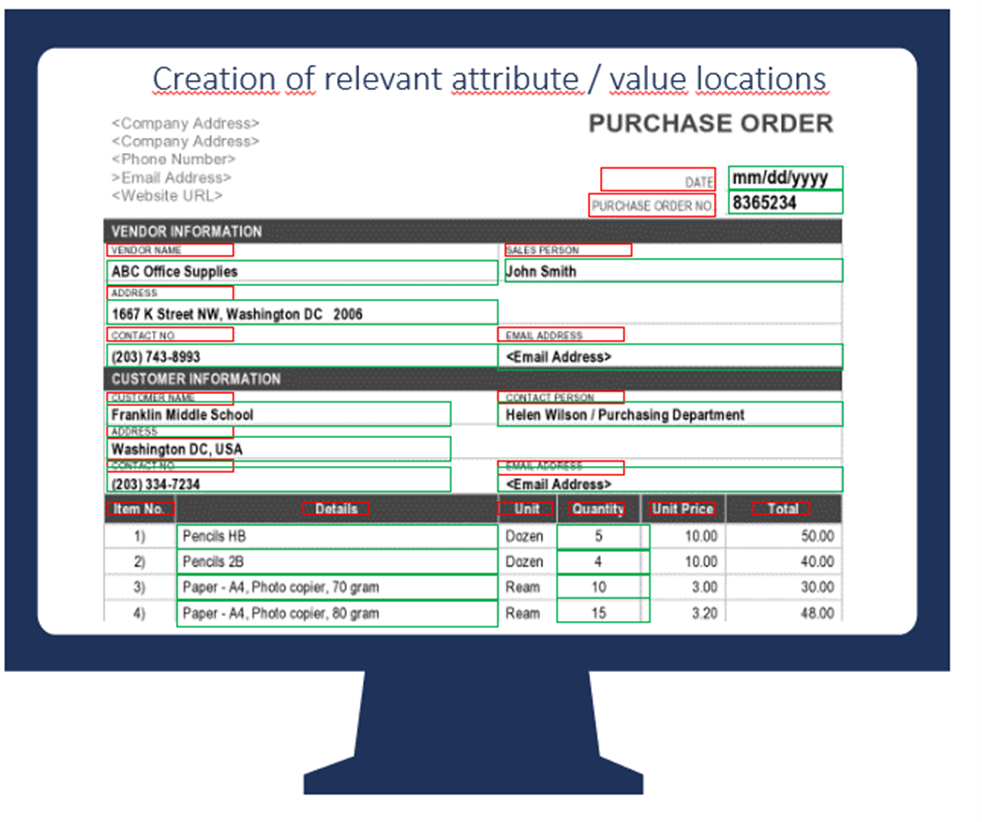There are many innovative concepts on how to use Artificial Intelligence in warehousing. You can find some in examples in our recent thought paper.
In this blog article, we would like to extend this overview by giving insights about an innovation to be possibly implemented in warehouse and your according future vision: Extreme Data Maintenance Automation that can be used for self-learning document scanning.
Extreme Data Maintenance Automation
Manual system maintenance of information based on paper forms is an activity that is part of everyday corporate life in many companies regardless of the size or the industry of the enterprise. This manual work is time consuming and creates a huge overhead. At the same time, manual maintenance of the results may also lead to human errors and employee dissatisfaction, due to the tedious process of entering the data. The CAMELOT Automated Data Extraction Tool (CADET) offers an automated cross-industry solution including streamlined information extraction and validation of any physical document. Extreme Data Maintenance Automation can be powered by SAP Data Intelligence. There are already first use cases.
Self-Learning Document Scanning in Warehousing
How can this innovation be applied in warehousing? Scanning a document and entering its data to an ERP system is currently a manual task. Employees read a document and then type the data into the system or confirm it. AI can be used to accelerate this process and enable a self-learning document scanning: The trained algorithm recognizes patterns of data in scanned documents and identifies features (such as date formats, headings, or other indicators) to pinpoint the type of master data and its content.
CAMELOT hosts in-house capabilities for this with a successful proof of concept. You can see an exemplary scan in the picture below:
Figure 1: Exemplary scan of a purchase order
Benefits & Restrictions
The main benefit of this technology is the simplification of document scans. This can lead to increased productivity by releasing employee capacities and eliminating incorrect entries. On top of that, the software uploads data to the ERP/WMS’s data structure. This means that there is no necessity to adapt your ERP/WMS. A further advantage is the technology´s capability to work with free-text documents, so that any document handed in can be processed.
As a result, the process of data entry is stream-lined: the employee places the document under the scanner, after which the system automatically identifies and uploads to the ERP.
Usually, the advantages outweigh the investment. In this case, you must consider that a self-learning algorithm needs guidance and training before it can be implemented and improve processes. At the beginning you have to invest your employees‘ capacities for the training of this algorithm. This is needed as a basis to derive the patterns and collect feedback from the employees whether the identified data is valid or false. Second, the algorithm learns over time, which means that the first results can be either misleading or demotivating. A typical sample size would be around 200 documents.
Even though this technology can be used in almost all warehouses, there are two driving factors that make the application of this technology obsolete. If you receive the document data for your warehouse via an API or other direct communication channels, where the data is allocated and entered directly to field entries, this makes this technology redundant. The other case would be if you receive a very limited number of documents, resulting in a comparatively low savings potential in relation to the investment.
Conclusion
When it comes to the application of AI and subsequent innovations in warehousing, organizations have many possibilities and are likely to require guidance. The innovations described only scratches the surface of what is possible. However, complex concepts such as a “dark warehouse,” a warehouse completely without people, are still in the distant future.
Many innovations result in increased efficiencies, optimization of processes and resource utilization or reduced costs. However, there is always a proper setup needed. As described above, artificial intelligence needs training and binds employee capabilities.
CAMELOT regularly reviews and discusses innovations like these during joint workshops with our customers regarding their digital warehousing vision. We provide you with insights, expertise, and guidance on how and whether you should apply these innovations and if your individual situation is set for such efforts. If you want to know about additional ai-driven innovations or integrate innovative technologies into your digital warehouse future vision, contact us.
We would like to thank Thomas Grill and Albert Peychal-Heiling for their valuable contribution to this article.
More insights:


